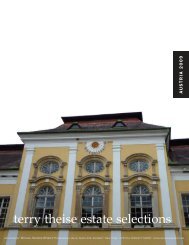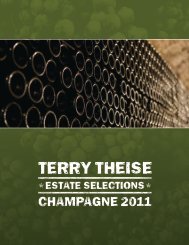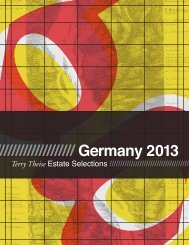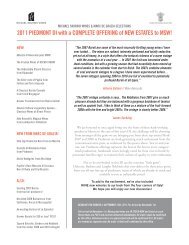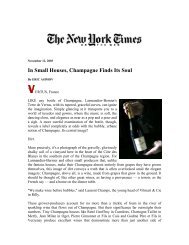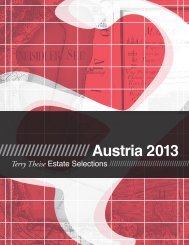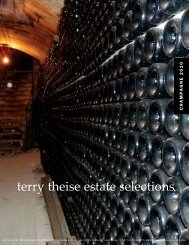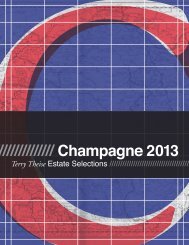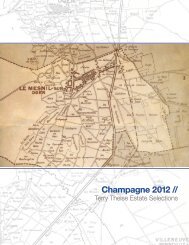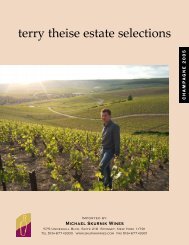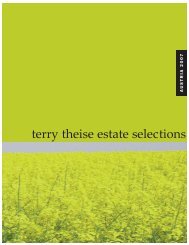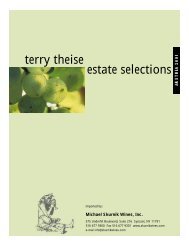German Catalog 2006 USE THIS ONE.qxp - Michael Skurnik Wines
German Catalog 2006 USE THIS ONE.qxp - Michael Skurnik Wines
German Catalog 2006 USE THIS ONE.qxp - Michael Skurnik Wines
Create successful ePaper yourself
Turn your PDF publications into a flip-book with our unique Google optimized e-Paper software.
34<br />
around until he gets fluent in the new cellar-regime. His<br />
residually-sweet 2004s were all made by stopping fermentation<br />
(is this not also manipulation???? Oh don’t<br />
even get me started). There was a Scheurebe I liked and<br />
which needed to be sweeter, so we tried it two ways—one<br />
using dosage and the other by blending an Auslese into<br />
the base wine.<br />
It was unanimous; the wine with dosage was clearly<br />
superior.<br />
So-called “Süssreserve” (literally sweet-reserve) is<br />
unfermented grape juice separated during the harvest<br />
and kept under pressure (carbon dioxide or nitrogen),<br />
eventually re-blended into a wine in order to fine-tune<br />
the final sweetness. Thus harmony of flavor is assured—<br />
at least in theory. I intervene as often as I can in this<br />
process, as I have definite ideas about harmony. Where<br />
the story of a blend is interesting I’ll share it with you.<br />
Actually, I have decided that I don’t like the word<br />
“Süssreserve” any more and I won’t use it in this text.<br />
Since nobody objects to the idea of Dosage in<br />
Champagnes, and since Süssreserve has connotations of<br />
unnatural manipulation to some people—and since the<br />
two words mean the SAME THING—I think I’ll use the<br />
nicer one.<br />
Another interesting digression (I am full of these, or at<br />
any rate, full of something): when you’re blending with<br />
Süssreserve, you first produce a makeshift blend based<br />
on an intuition of what the base wine seems to need. It’s<br />
often wrong, so you add or subtract in the direction you<br />
wish to move. Much of the time the wine seems sweetsour,<br />
with sugar unknit and detached from fruit and<br />
acidity, standing out like a sore thumb. You’d be tempted<br />
to conclude you’d used too much sweetening. You’d be<br />
wrong. Most of the time you don’t need less sweetness;<br />
you need more. And as you inch upward in increments<br />
you’ll find when you’ve got the blend perfect the sweetness<br />
seems to VANISH! Now it’s part of a balanced,<br />
whole picture. I’m tempted to believe that most of the<br />
anti-Süssreserve crap you hear results from poorly blended<br />
wines from vintners who didn’t respect their material<br />
and were only interested in the quickest shortcut to a<br />
saleable product.<br />
In any case I applaud purism in most places it is found,<br />
but the anti-dosage crusade in <strong>German</strong>y smacks not of<br />
science but of religion. I am quite certain that thousands<br />
of growers used dosage willy-nilly—still do—but that<br />
only demonstrates there’s plenty of hacks making wine. I<br />
doubt very much they’d make better wine by stopping<br />
fermentation. Hacks are hacks. Dosage has been seized<br />
upon by a community of growers a little too eager to polish<br />
their halos. It is a convenient symbol of manipulation,<br />
but this is silly; all winemaking is manipulation, and the<br />
authentic questions are not whether to manipulate (one<br />
already does) but rather how to manipulate and to what<br />
end. What we call “non-manipulation” (with rather an<br />
excess of romanticism) is more properly called minimal<br />
manipulation. We prefer growers whose wines are guided<br />
by a wish to preserve natural inherent flavor rather<br />
than ladling all kinds of cellar-sauce over it.<br />
<strong>Wines</strong> made sweet by stopping fermentation do have<br />
their “own” sweetness, but I’m not willing to presume this<br />
is superior, and certainly not as a matter of faith or ideology.<br />
Sometimes it is, sometimes it isn’t. True “residual”<br />
sugar has a higher proportion of fructose: therefore it<br />
tastes sweeter and “heavier”. Stopping fermentation<br />
involves either chilling, racking through filters or sulfuring.<br />
In fact these more “natural” wines require more sulfur<br />
than those made with dosage. Andreas Adam insists<br />
“Süssreserve falsifies terroir!” and I’m delighted by how<br />
much he cares about terroir, and if you have to err then it’s<br />
damn sure preferable to err on the side of purism. But<br />
what he says ain’t necessarily so. And there’s the crux:<br />
young growers are also young people, and young people<br />
like things to be categorical. Then life kicks our ass and we<br />
get more humble.<br />
A reasonable compromise is to stop your fermentations<br />
but also to keep a little dosage around. After all, how<br />
can you be sure you stopped at just the perfect point? The<br />
wine is turbulent and yeasty. Isn’t it at least prudent to<br />
give yourself options? Believe me, every wine is easier to<br />
judge several months later.<br />
This was especially apropos in both 2003 and 2005,<br />
largely because of the Kabinett “problem”. That is, the<br />
paucity of actual Kabinett, in favor of wines of (sometimes)<br />
legal-Auslese ripeness labeled as Kabinett. Many<br />
Mosel growers used what little they picked below 90<br />
Oechsle (weak Auslese but still above the legal minimum)<br />
for Kabinett: 90-100 was Spätlese and over 100 was<br />
Auslese. Back in 1983 most growers didn’t pick anything<br />
above 100 Oechsle and were happy to bottle Auslese with<br />
90 degrees; times have changed.<br />
But what’s to be done about the sweetness? If your<br />
Kabinett usually has 80 Oechsle and 40g.l. sweetness, the<br />
same 40g.l. will taste deficient with a markedly riper<br />
must. If you calibrate the sweetness to the actual wine,<br />
the result may be too sweet for “Kabinett”. I must have<br />
tasted 25-30 wines with misjudged sweetness based on<br />
this very conundrum. Dosage was either the solution, or<br />
would have been.<br />
I wonder whether the anti-dosage sentiment doesn’t<br />
arise from a puritanical disapproval of sweetness, especially<br />
sweetness “added” deliberately. No one would say<br />
this outright, but I feel its presence. Thus stopped fermentation,<br />
especially if it stops spontaneously, can be<br />
excused; oh well, nature wanted it that way. And so the<br />
argument isn’t really about dosage, terroir or purism; it is<br />
a shadow-argument about ameliorating the despicable<br />
sweetness.<br />
FLURBEREINIGUNG: Literally this means the “rectification<br />
of the fields.” It’s actually a process whereby costs<br />
of production are diminished by rationalizing land holdings<br />
and building roads, paths, and walkways. Formerly<br />
the growers’ holdings were split into myriad tiny parcels<br />
and scattered hither and yon over the hillside. Often<br />
there was no easy access. It could take a longer time to<br />
get to one’s vines that to actually work them.<br />
In Flurbereinigung, the entire expanse of a vineyard is



